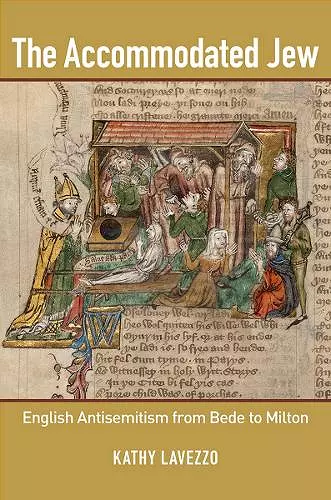The Accommodated Jew
English Antisemitism from Bede to Milton
Format:Hardback
Publisher:Cornell University Press
Published:21st Oct '16
Should be back in stock very soon

England during the Middle Ages was at the forefront of European antisemitism. It was in medieval Norwich that the notorious "blood libel" was first introduced when a resident accused the city's Jewish leaders of abducting and ritually murdering a local boy. England also enforced legislation demanding that Jews wear a badge of infamy, and in 1290, it became the first European nation to expel forcibly all of its Jewish residents. In The Accommodated Jew, Kathy Lavezzo rethinks the complex and contradictory relation between England's rejection of "the Jew" and the centrality of Jews to classic English literature. Drawing on literary, historical, and cartographic texts, she charts an entangled Jewish imaginative presence in English culture.
In a sweeping view that extends from the Anglo-Saxon period to the late seventeenth century, Lavezzo tracks how English writers from Bede to Milton imagine Jews via buildings—tombs, latrines and especially houses—that support fantasies of exile. Epitomizing this trope is the blood libel and its implication that Jews cannot be accommodated in England because of the anti-Christian violence they allegedly perform in their homes. In the Croxton Play of the Sacrament, Marlowe's The Jew of Malta and Shakespeare's The Merchant of Venice, the Jewish house not only serves as a lethal trap but also as the site of an emerging bourgeoisie incompatible with Christian pieties. Lavezzo reveals the central place of "the Jew" in the slow process by which a Christian "nation of shopkeepers" negotiated their relationship to the urban capitalist sensibility they came to embrace and embody. In the book's epilogue, she advances her inquiry into Victorian England and the relationship between Charles Dickens (whose Fagin is the second most infamous Jew in English literature after Shylock) and the Jewish couple that purchased his London home, Tavistock House, showing how far relations between gentiles and Jews in England had (and had not) evolved.
The Accommodated Jew represents literary criticism at its best. Lavezzo examines a topic of enduring relevance—anti-Semitism—and she demonstrates in perfectly clear, at times even witty, prose the complications and long reach of how the English literary imagination conceived of Jews and their homes. Lavezzo shows how ancient texts remain deeply relevant today even as she carefully situates them in their various historical contexts. I learned a great deal from this book, and I thoroughly enjoyed reading it. That's not something I can say very often.
(Journal of Jewish Identities)In her sustained and deeply nuanced examination of the geographical tropes Lavezzo offers novel and perceptive readings that ought to be of genuine interest to scholars seeking to understand both anti-Semitism and early modern English culture.... Lavezzo's work provides a highly successful model for pursuing the program of cognitive mapping as a way to understand how spaces inform our sense of life.
(Renaissance Quarterly)Vivid anaylsis of well-known texts by the Venerable Bede, Chaucer, John Marlowe, and John Milton, coupled with authors less well known to non-specialists but important in substantiating and contextualizing the cultural concept.... Lavezzo's book reminds us of the importance of humanistic inquiry and the ways it can help us understand or at least ask pressing questions of the cultural artifacts we produce and consume.
(Journal of British Studies)Lavezzo is always illuminating, and her rich individual readings of the works of Bede, the Croxton Play of the Sacrament, Chaucer's Prioress's Tale, The Jew of Malta, and Samson Agonistes reconceptualize our thinking on each of these works and, by extension, the presence of the figure of the Jew in English culture.
(The Jewish Quarterly Review)The Accommodated Jew addresses multiple audiences gracefully, offering new readings of familiar texts alongside explication of social and economic structures for those unfamiliar with the period in question. It will be of interest to medievalists, early modernists, and Jewish studies scholars alike.
(H-Net: H-Judaic)Lavezzo takes a completely novel approach by examining premodern English depictions of Jews in terms of spatial and geographic relations.
(Journal of English and Germanic Philology)This intricate, thorough, and wide-ranging analysis introduces the locations and spaces allegedly occupied by Jews from circa the eight to tenth through the seventeenth centuries.... Another quieter... part of Lavezzo's project involves intervening in the way that medievalists think through what constitutes 'the Jew'.... Lavezzo builds a strong argument for her reading of an 'accommodated Jaw' in six richly-detailed chapters and through twenty-four valuable images (maps, pictorials, and pictures) that complement her claims.
(Speculum)Lavezzo has made a strong case for her focus on the habituations of Jews, with copious details that relate to anti-Jewish bigotry. Each chapter is well documented in recent scholarship and the bibliography and index are aids to further study.
(SIXTEENTH CENTURY JOURISBN: 9781501703157
Dimensions: 229mm x 152mm x 32mm
Weight: 907g
392 pages